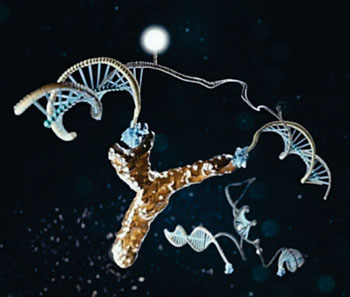Diagnostic Antibodies and Proteins Detected with DNA Nanomachines
By LabMedica International staff writers
Posted on 28 Oct 2015
A nanoscale machine composed of synthetic DNA can be used for the rapid, sensitive and low-cost diagnosis of many infectious and autoimmune diseases, including human immunodeficiency virus (HIV) and rheumatoid arthritis (RA). Posted on 28 Oct 2015
A versatile platform for the one-step fluorescence detection of both monovalent and multivalent proteins has been developed and is based on a conformation-switching stem-loop DNA scaffold that presents a small-molecule, polypeptide, or nucleic-acid recognition element on each of its two stem strands.

Image: The light-generating DNA antibody detecting nanomachine is illustrated here in action, bound to an antibody (Photo courtesy of Marco Tripodi).
Scientists at the University of Rome Tor Vergata (Italy) working with their North American colleagues designed and synthetized a nanometer-scale DNA "machine" whose customized modifications enable it to recognize a specific target antibody. Their new approach promises to support the development of rapid, low-cost antibody detection at the point-of-care, eliminating the treatment initiation delays and increasing healthcare costs associated with current techniques. The protein-targeting sensor is composed of a fluorophore/quencher-modified DNA stem–loop system containing two single-stranded tails. To create a target-responsive sensor, these tails are hybridized with DNAs conjugated to an appropriate recognition element.
The binding of the antibody to the DNA machine causes a structural change or switch, which generates a light signal. The sensor does not need to be chemically activated and is rapid, acting within five minutes, enabling the targeted antibodies to be easily detected, even in complex clinical samples such as blood serum. The versatility of the platform was demonstrated by detecting five bivalent proteins (four antibodies and the chemokine platelet-derived growth factor) and two monovalent proteins (a Fab fragment and the transcription factor TATA Box Binding Protein (TBP) with low nanomolar detection limits and no detectable cross-reactivity.
Francesco Ricci, PhD, a professor and senior coauthor of the study, said, “One of the advantages of our approach is that it is highly versatile. This DNA nanomachine can be in fact custom-modified so that it can detect a huge range of antibodies; this makes our platform adaptable for many different diseases.” The materials needed for one assay cost about USD 0.15, making the approach very competitive in comparison with other quantitative approaches. The study was published on September 4, 2015, in the journal Angewandte Chemie.
Related Links:
University of Rome Tor Vergata










 (3) (1).png)



